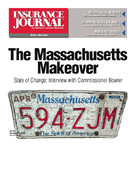If Massachusetts were to ever elect its insurance commissioner, Julianne Bowler would probably be the last person to run. Bowler, the current occupant of the appointed office in this very political state, is too modest, too private and too press-shy to ever campaign for the job.
Bowler’s style is to dive into issues without making a big splash. This means getting to the important issues, listening to all the players, and coming up with workable solutions.
“I don’t believe in regulating by headlines the way some do,” says the commissioner, who was named to her post by former Gov. Jane Swift in April 2002 to fill the shoes of Linda Ruthardt and then reappointed by current Gov. Mitt Romney in 2003.
Bowler doesn’t grant many interviews but she did agree to sit down with Insurance Journal recently. She shared her views on the industry charges lobbed by New York Attorney General Eliot Spitzer, the coastal homeowners market, the possibility of a regional catastrophe fund, and, of course, the state’s auto market.
Good citizens
Unlike many of her predecessors, Bowler’s not afraid to say some nice things about the industry she regulates, nor is she afraid to admit that she wants the insurance markets to be good for insurers and agents as well as consumers.
“The industry fascinates me,” she said. “The issues are intellectually stimulating.”
What’s more she thinks the industry is good for the state but under-appreciated. “This industry is so important to our economy and does such good things for people,” she noted, citing the hundreds of millions of dollars in premium taxes insurers pay and the 100,000 jobs the industry creates directly and indirectly.
“When there’s a disaster, they are there writing out the checks. They do an awful lot of good yet nobody says, ‘Look at what these guys do for our community.'”
Her admiration for the industry’s good citizenship is not confined to insurance companies. “Look at what the agents do … I mean you could not have a Little League program if you didn’t have agents who were basically willing to underwrite it,” she cited as an example.
She agrees with those who see part of the commissioner’s job as trying to keep and attract more insurers. “That’s why I get painted as anti-consumer. But I think it’s a great industry for the state and I believe consumers in the long run benefit if we have a robust insurance market.”
Steps taken
Since Bowler assumed the reins at the division of insurance, the state has taken a number of steps to improve its insurance climate. The state that is known for its tight regulation recently deregulated some commercial lines, giving insurers more flexibility to meet the needs of larger risks. It has overhauled the operations of the commercial auto high risk market. The state has also averted the severe crises in workers’ compensation and medical malpractice that have dogged other states.
Not everything has worked out to the industry’s liking. An attempt to clarify how insurers could employ credit scoring was cut short in the face of negative reaction in the press and by some legislators.
Still, it is its unique private passenger auto insurance system that dictates the Bay State’s insurance image and where Bowler–and virtually every one of her predecessors–spends much of her time and energy. Only 19 insurers, most of them regional, still insure autos in the state. But now, even this signature market is about to change, thanks in great measure to Bowler’s persistence and style.
Currently, reform of the state’s high risk auto insurance pool, Commonwealth Auto Reinsurers (CAR), is on the top of her agenda. The proposal under consideration would convert the current reinsurance pool into an assigned risk type plan, known as the Massachusetts Assigned Insurance Plan or MAIP. It alters the way high risks are assigned to insurers and how they are serviced. This effort has been underway for years but has finally entered a final round of hearings.
The actual reform process began in June, 2002 with a letter from Attorney General Tom Reilly whose office had conducted a study that found that the current CAR plan does not fairly distribute the costs of high risk policies, which was a violation of the law governing CAR. Bowler then brought in every company and CAR board agents to educate her and the department about how the system was working, and not working. She followed up by commissioning another study by Tillinghast that confirmed the need for reform.
Lengthy process
“I think it has taken somewhat longer than we thought it would,” acknowledged Bowler about the process. “I think maybe we were overly-optimistic about how soon we could do this.”
Yet she defends the lengthy process as one that has allowed everybody’s concerns to be heard.
“I think we’ve demonstrated that the administration is committed to improving this market for everybody, for the drivers, for the agents and for the companies. I think we’ve demonstrated our commitment over the past two years.
“I also think we’ve demonstrated that we’re inclusive. We don’t have a single opinion or run headstrong by ourselves without listening. We have spent a lot of time listening to everybody including the companies and consumer advocates who are not fully supportive of the plan as it’s been proposed. We take very seriously what their concerns are because we want a solution that works for everybody.”
While CAR is the biggest target for auto insurance reform, it is not the only one. The state’s rating territories and surcharge system for bad drivers are also undergoing changes. In addition, Bowler has named reform-minded directors to the board of CAR.
While new capital is not yet flowing in, the combined efforts recently convinced one insurer, Fireman’s Fund, which had planned to exit the market, to stick around for at least another year to see if the process bears fruit.
As important as the regulatory changes to CAR are, Bowler does not want to oversell them.
“While CAR is a necessary fix it probably will not be a sufficient fix to get new capital into the market but it has to be done because the burden is not fairly distributed,” she explained.Bowler said the legislature would have to decide whether to make any other changes. In April, Gov. Romney named a task force to report on possible legislative fixes by year’s end.
Coastal markets
Bowler’s concern over retaining and attracting insurance capital spills over into other lines of insurance, notably homeowners, where restrictions in coastal property writings have been felt since last spring. The coastal homeowners availability crisis came to a head when one of the region’s largest homeowners carriers, Andover Companies, announced it would not renew about 14,000 Cape policies. Within days, Vermont Mutual Insurance Co. and the Norfolk & Dedham Group imposed a moratorium on new Cape business. Other insurers, including OneBeacon, Commerce and Safety also cut back.
It’s no longer in the headlines but the problems haven’t gone away. “We still have concern about the capital adequacy of that market,” Bowler said.
Bowler said the market difficulties are made more difficult by several factors: the current rates in the residual market, or the FAIR Plan; the use of catastrophe models; and the fact that the state is dominated by regional carriers and does not have a large national player such as State Farm or Allstate–a reality traceable to the auto market.
Catastrophe models have driven up the cost of writing policies in coastal areas. Insurers use them to assess their potential losses, but reinsurers and rating firms also use them to gauge reinsurance needs and prices for these carriers. Carriers are required to purchase more and increasingly expensive reinsurance.
But in Massachusetts, carriers bump into the state’s residual market when they go to recoup these reinsurance costs in coastal homeowners premiums. The state’s FAIR Plan actually sells a homeowners policy, not just a fire policy like other residual markets. Also, because of controls placed on rates by law, FAIR Plan homeowners policies can be less expensive than voluntary market policies in certain areas, including Cape Cod and other seaside communities. In terms and in pricing, the FAIR Plan represents a good deal for consumers–perhaps too good–and a bad deal for private carriers that must compete with the residual market. Attempts to change the law on FAIR Plan rates have failed the past several years.
This scenario presents a further concern for a regulator, adds Bowler, because these same voluntary market insurers are the ones who pay for both the FAIR Plan and the guaranty fund, which is triggered to play claims if an insurer goes under.
“It’s like Russian roulette” for carriers, Bowler said, and represents how one insurance market can influence another. “No company wants to come here to write only one line,” she noted. If a company is going to write in Massachusetts, it wants to write both auto and homeowners, she maintained. But because the auto market is troublesome, it has scared away companies with a diversified national book of business that could relieve some of the pressure in the state’s homeowners market.
“So we have to fix the auto situation in order to fix homeowners,” she stressed.
Part of the coastal property solution could lie beyond the state’s own borders. The Massachusetts department has broached the idea of a catastrophe fund along the lines of the facility that is winning industry accolades in Florida following the hurricanes. But Bowler’s staff has determined the catastrophe problems–and the solution–are bigger than the geographically-challenged Bay State.
“The Florida model has worked and worked well. We looked at copying the Florida cat fund. However, because Massachusetts is so small, if we just did it for only Massachusetts, it wouldn’t work,” she said. One state represents too small a base on which to build the fund, she said.
Instead, what might work is a northeast regional catastrophe fund that brings in the premium volume from New York, New Jersey, maybe even Pennsylvania, along with the New England states’ volume. “We’ve had a number of independent conversations with our peers in other states and there definitely is interest,” Bowler offered.
The prospect of a regional cat fund is complicated by the fact that each state has a different worry. While Long Island, Cape Cod and Rhode Island may share concerns over coastal catastrophes, New York City and the District of Columbia view terrorism as their biggest catastrophe risk. “So the question is whether there is a way to develop a cat fund that can meet the needs of individual states,” Bowler said, adding that it will take cooperation among state legislatures if it is to ever happen.
Spitzer probe
No commissioner can escape being asked about the allegations of bid rigging, account tying and account steering brought by New York Attorney General Eliot. Bowler is quick to separate the issue of bid rigging from complaints over contingent commissions. When it comes to bid rigging, she does not mince her words:
“The accusations of bid rigging if proven are outrageous. I cannot believe that people would do this. I think that caught a number of us short. I mean, who do these people think they are? It’s outrageous. It’s criminal. There is absolutely no excuse, no defense whatsoever, not only on the part of the brokers but on the part of any company that was complicit in this and knew that they were doing it.”
Part of the reason Bowler has no patience for this type of activity is that she does not feel it is representative of the industry as a whole. “Obviously there will always be cowboys but one thing I am concerned about is that suddenly we’ve got everybody painted with this same broad brush,” she commented.
The complaints over contingent commissions fall into a different category in her mind because she does not think they are illegal. They might be questioned where there is a fiduciary relationship between an advisor and a client. But, as Bowler notes, at least in Massachusetts, not one but two key court decisions have found that agents and brokers do not have a fiduciary relationship with their clients. Bowler believes it would take a new statute to create such a fiduciary relationship. “I can’t do it by bulletin; I can’t force a fiduciary relationship,” she told Insurance Journal.
Her department has contacted every one of the state’s domestic companies to inquire about their practices and will conduct market examinations where appropriate, she said.
NAIC template
As for a remedy to any wrongdoing, Bowler is working with the National Association of Insurance Commissioners (NAIC) to come up with a coordinated approach that can be implemented in all states. “We are trying to create a coordinated response to the problem because the problem is national,” she explained.
In terms of contingencies, she said commissioners are grappling with how to proceed, whether to prohibit them or just mandate disclosure. She anticipates that the NAIC will be able to quickly develop a model law covering the issues.
“I’m hopeful that the response will be coordinated, that the template will be the same. You don’t want companies writing in 50 states responding to 50 different rules,” she stated.
Bowler realizes that because her style is low key, some of the things her department staffers do fall under the public’s radar. Among them is the job they do ferreting out improper practices.
“We have a pretty good track record when it come to identifying and correcting misbehavior in the marketplace whether it’s taking licenses, or fining and requiring additional training, we basically do a pretty good job…but we don’t toot our own horn.”
That would be too much noise for this regulator.
Was this article valuable?
Here are more articles you may enjoy.


 Markel Insurance Restructures Markel Specialty, Appoints Leaders
Markel Insurance Restructures Markel Specialty, Appoints Leaders  Class Action Accuses Toyota of Illegally Sharing Drivers’ Data With Progressive
Class Action Accuses Toyota of Illegally Sharing Drivers’ Data With Progressive  South Florida Insurance Broker Pleads Guilty to Fraud in $133M ACA Enrollment Scheme
South Florida Insurance Broker Pleads Guilty to Fraud in $133M ACA Enrollment Scheme  3 Emerging Risks to Watch: 6G Wireless Technology, Autonomous Trucks, Kratom
3 Emerging Risks to Watch: 6G Wireless Technology, Autonomous Trucks, Kratom 


